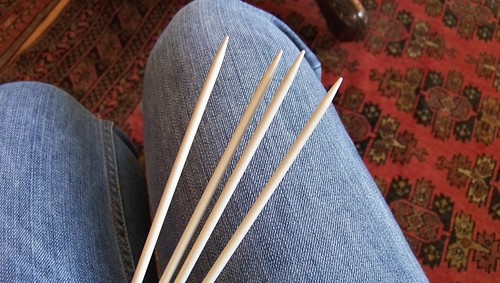Here is yet another project courtesy of the felted wool sweater. It’s a present for the newest addition to Kª and Kº’s family. We shall have to see what young Il Principe thinks of this. Being an only child is pretty sweet.

Here I took four sweaters, two gray, one navy, and one black. These sweaters were of the softer, thinner natural fabrics, such as cashmere and merino. They felt a bit differently than regular sheep’s wool, with less fuzz. I cut those suckers up into tons of 3″ squares.
Then I laid them out into a pattern and, like in our other wool patchwork quilt, started sewing them together in long strips.
Because of the nature of the wool I had to do it all by hand, with a needle and thread, using the blanket stitch.
Then I sewed the strips together. 
It looks rather nice, don’t you think?
This is the back of it. It’s kind of cool, too, but it will be hidden from view. This is the soft cotton I am going to use as the backing. The blue and the gray match perfectly with the colours of the wool.
This is the soft cotton I am going to use as the backing. The blue and the gray match perfectly with the colours of the wool.
Then with great care I pinned the top to the backing. 
The backing is a grid pattern so I was careful to line things up properly. 
I folded over the edges of the cotton to guard against fraying.
Then, with great difficulty owing to the stretchiness of the wool, I machine-basted the two pieces together. Next time I would probably do this by hand, just because of the way the wool bunched and stretched.
To bind it, I used blanket binding, which I folded in on itself to make smaller. Shockingly, I had to actually PURCHASE the blanket binding from Fabricland.
It was a simple matter to fold it towards its own centre …
My mother was kind enough to sew the binding onto the blanket for me, in exchange for my making of kumquat marmalade. She has more patience for such things.
The corners are a bit tricky. You can see here how Mum pins flush across the corner.
Then folds the fabric over the pin as a guide.
Then pins it in place before sewing it down.
You can see at the end she just folded it under itself again before sewing it down.
Embellishments are always important when it comes to babies, but you have to be careful. No buttons, or anything that babies can eat. Colourful yarn is a good option. I thought the orange would look great next to the gray and blue.
The yarn here also serves to anchor the top of the quilt to the bottom so it doesn’t shift around.
I threaded a tapestry needle with the yarn.
Poked it through and back out again.
This is what it looks like on the back.























































































